Legendary NFL, Movie Star and Activist Jim Brown Dies at 87
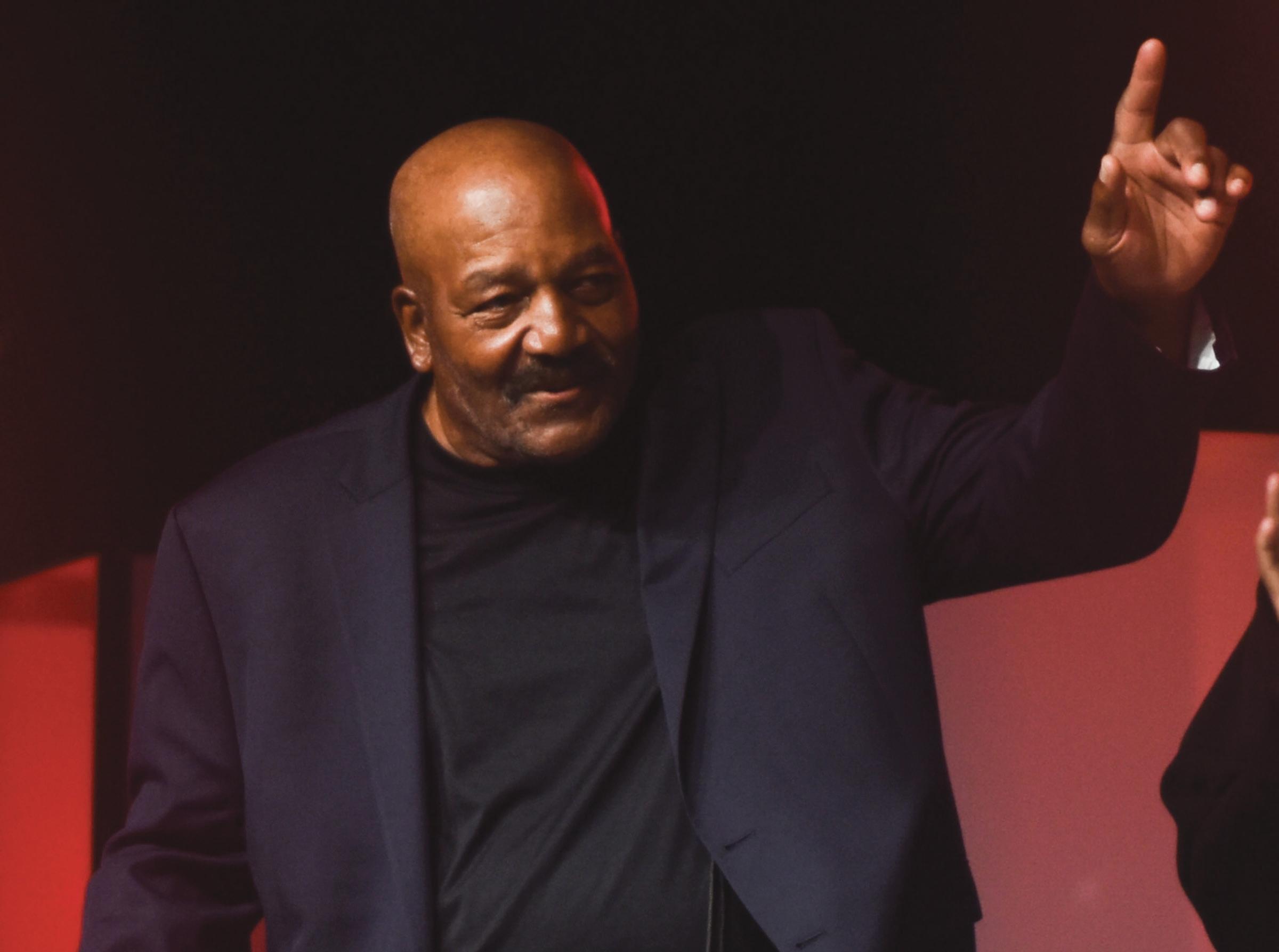 By Stacy M. Brown NNPA Newswire Senior National Correspondent
By Stacy M. Brown NNPA Newswire Senior National Correspondent
Jim Brown, the superstar Cleveland Browns running back who quit football at the very height of his hall-of-fame career, has died at 87.
Perhaps the greatest running back ever, Brown quit football to pursue an acting career at 30.
From 1957 to 1965, the perennial all-pro helped lead a Cleveland Browns ground game that won an NFL championship in 1964.
Voted pro football’s greatest player of the 20th century, Brown earned induction into the Hall of Fame in 1971. But football wasn’t the only sport in which he excelled.
He played basketball, track, and lacrosse at high levels.
He was inducted into the Lacrosse Hall of Fame in 1984.
But football is where he chiefly left his mark.
Notably, in 1965, Cleveland Brown’s owner, Art Modell, issued an ultimatum to the superstar, telling him that if he continued filming the hit movie, “The Dirty Dozen,” which was delayed because of technical problems, Brown would face fines for reporting late to training camp.
Ever independent, Brown defied Modell and called a press conference to announce his retirement from football.
Brown also didn’t hesitate to speak out on issues affecting African Americans and openly supported the civil rights movement.
He started and helmed the Negro Industrial and Economic Union to create jobs for Black people in Ohio.
The organization also helped secure loans for Black businesses.
Brown also formed a coalition to denounce the federal government’s role in stripping boxing legend Muhammad Ali of his title because Ali refused to fight in the Vietnam War.
Continued on page A3
California Panel Takes Big Step Toward $800 Billion Reparation Payments to Black Residents, and Formal Apology
By Stacy M. BrownNNPA Newswire Senior National Correspondent
California’s reparations task panel approved recommendations to compensate and apologize to Black communities for centuries of discrimination.
At a meeting in Oakland, the nine-member committee, which first met nearly two years ago, approved a lengthy list of reparations recommendations for state lawmakers to examine.
At the meeting, U.S. Rep. Barbara Lee (D-Calif.), called on states and the federal government to implement reparations legislation.
Lee said reparations are morally justified and could solve historical racial imbalances and inequality.
The panel’s first vote accepted a detailed assessment of Black Californian discrimination in voting, housing, education, disproportionate policing and incarceration, and others.
Other suggestions included creating a new organization to serve descendants of enslaved people and calculating what the state owes them.
“An apology and an admission of wrongdoing alone is not going to be satisfactory,” said Chris Lodgson, an organizer with the Coalition for a Just and Equitable California, a reparations advocacy group.
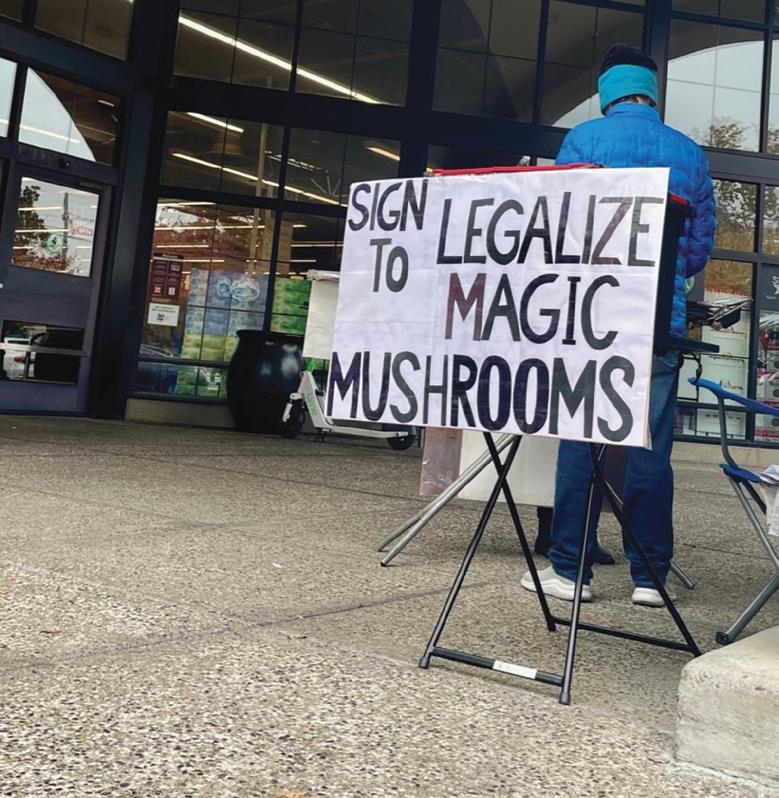
The task force’s draft recommendation requires parliamentarians to “censure the gravest barbarities” on behalf of the state in their apologies.
The task force noted that California’s first elected governor, Peter Hardeman Burnett, was a white supremacist who supported legislation excluding Black people from the state.
The draft report states that California, a “free” state since 1850, did not pass any laws guaranteeing freedom for all. Instead, the state Supreme Court enforced the federal Fugitive Slave Act for over a decade until freedom arrived in U.S. states.

“By participating in these horrors, California further perpetuated the harms African Americans faced, imbuing racial prejudice throughout society through segregation, public and private discrimination, and unequal state and federal funding,” the study authors wrote. The task team adopted a public apology, admitting the state’s past wrongs and committing not to repeat them.
It would be presented to the descendants of enslaved people.
California apologized for interning Japanese Americans and mistreating Native Americans.
The panel adopted the draft report’s “cash or its equivalent” restitution for qualified residents.
Oakland’s Mills College of Northeastern University hosted over 100 citizens and activists. All lamented the country’s “broken promise” to give emancipated slaves 40 acres and a mule.
Many claimed it was time for governments to fix the harms
Adidas to Start Selling Stockpile of Yeezy Sneakers
By ANNE D’INNOCENZIOAP Retail Writer
NEW YORK (AP) – Adidas said Friday that it will begin selling its more than $1 billion worth of leftover Yeezy sneakers later this month, with the proceeds to be donated to various anti-racism groups.
The German sportswear brand said recipients will include the Anti-Defamation League, which fights antisemitism and other forms of discrimination, and the Philonise & Keeta Floyd Institute for Social Change, run by social justice advocate Philonise Floyd, the brother of George Floyd.

“After careful consideration, we have decided to begin releasing some of the remaining Adidas Yeezy products,’’ said Adidas CEO Bjorn Gulden in a statement. “Selling and donating was the preferred option among all organizations and stakeholders we spoke to. There is no place in sport or society for hate of any kind and we remain committed to fighting against it.”
Yeezy products have been unavailable to shoppers since Adidas terminated its partnership with Ye, formerly known as Kanye West, in October 2022 following his antisemitic comments on social media and in interviews.
The items to be sold include existing designs as well as designs that were in the works in 2022 for sale this year, Adidas said.
At Adidas’ annual shareholders meeting earlier this month, Gulden said the company had spent months trying to find solutions before deciding against destroying the items and to rather sell them to benefit various charities that were harmed by what Ye said.
The company said Friday that the move has no immediate impact on the company’s current financial guidance for 2023.
Copyright 2023 The Associated Press. All rights reserved. This material may not be published, broadcast, rewritten or redistributed without permission.

Judge Finds Bathroom Graffiti Violated Civil Rights Act, Orders Teen to Write Essay
MANCHESTER, N.H. (AP) – A New Hampshire teenager has been ordered to write a 3, 000-word essay discussing “the impact of racism and racist speech on society” after a judge found that he violated the state’s civil rights act by carving graffiti inside a high school bathroom directed at a Black teen.
In the order filed Wednesday, the judge said the 17-year-old must also do 100 hours of community service to avoid a $3,500 fine. He also was forbidden from engaging in or threatening physical force or violence against the victim and his family, or anyone else, or damage or trespass on their property. His lawyer did not respond to a message seeking comment. Prosecutors had asked for a $5,000 fine, the maximum penalty.
Judge Amy Messer found that the teen carved “Blacks stand no chance,” and part of “KKK” on a bathroom stall at John Stark Regional High School in Weare in April 2022. There already was other racemotivated graffiti on the wall and the name of a Black student who was “purportedly’’ one of the defendant’s friends, she wrote.
An attorney for the teen, who had faced a separate charge on the matter in juvenile court, argued he wasn’t motivated by race because he thought it was a joke, and that two other friends had pressured him into writing the graffiti. The lawyer also argued the words themselves “are not egregious and are historically accurate and not racially motivated,” according to Messer.
Prosecutors said the words are “steeped in race.”
Messer said she was “not convinced that the defendant was motivated to make a reflection of historical fact about the plight of Blacks in America in a public high school bathroom where racially charged graffiti already existed.”
Reactions to the Death of Jim Brown
Reactions to the death of Jim Brown, former NFL star, actor and activist:
California’s reparations task panel approved recommendations to compensate and apologize to Black communities for centuries of discrimination. At a meeting in Oakland, the nine-member committee, which first met nearly two years ago, approved a lengthy list of reparations recommendations for state lawmakers to examine.
that prevented African Americans from living without fear of being wrongly punished, maintaining property, and earning wealth.
Former Black Panther Party chairwoman Elaine Brown encouraged protests.
The task force meeting was viewed as a pivotal moment in the push for local, state, and federal agencies to apologize for African American discrimination.
“There’s no way in the world that many of these recommendations are going to get through because of the inflationary impact,” said University of San Diego School of Law professor and reparations specialist Roy L. Brooks.
Economists predict the state may owe Black residents $800 billion, or 2.5 times its yearly budget.
The newest task force draft report has a much lower figure.
In 2020, Secretary of State Shirley Weber, a former Democratic assemblymember, authored legislation creating the task force to address the state’s historical culpability for African American harms, not as a substitute for federal reparations.
The task team initially limited reparations to descendants of 19th-century enslaved or free Black individuals.
As reparations for African Americans have had uneven success elsewhere, the group’s work has received national attention.
Black residents in the Chicago suburb of Evanston, Illinois, recently received housing vouchers as reparations, but few reportedly used them.
A bill to acknowledge the inhumanity of slavery in New York and form a panel to investigate reparations proposals has cleared the Assembly but not the Senate.
A decades-old federal proposal to form a reparations panel for African Americans has stalled in Congress.
Oakland City Council member Kevin Jenkins called the California task group “a powerful example” of what can happen when people work together.
Jenkins stated, “I am confident that through our collective efforts, we can significantly advance reparations in our great state of California and, ultimately, the country.”
“We lost a hero today. Rest in Paradise to the legend Jim Brown. I hope every Black athlete takes the time to educate themselves about this incredible man and what he did to change all of our lives. We all stand on your shoulders Jim Brown. If you grew up in Northeast Ohio and were Black, Jim Brown was a God. As a kid who loved football, I really just thought of him as the greatest Cleveland Brown to ever play. Then I started my own journey as a professional athlete and realized what he did socially was his true greatness. When I choose to speak out, I always think about Jim Brown. I can only speak because Jim broke down those walls for me.” - NBA star LeBron James, on Instagram.
“I was too young to remember Jim Brown’s playing days, but I knew his legacy. One of the greatest football players ever, he was also an actor and activist - speaking out on civil rights, and pushing other Black athletes to do the same. Our thoughts are with Jim’s wife Monique, his children, and everyone who knew and admired him.” - Former President Barack Obama, on Twitter.
World & Nation
Tenn. Rep. Justin Jones Talks About His Expulsion, Gun Control at Calif. State Capitol
Antonio Ray Harvey
California Black Media
Last Week, the California Legislative Black Caucus (CLBC) welcomed Tennessee lawmaker and Oakland native Justin Jones to the State Capitol in Sacramento.
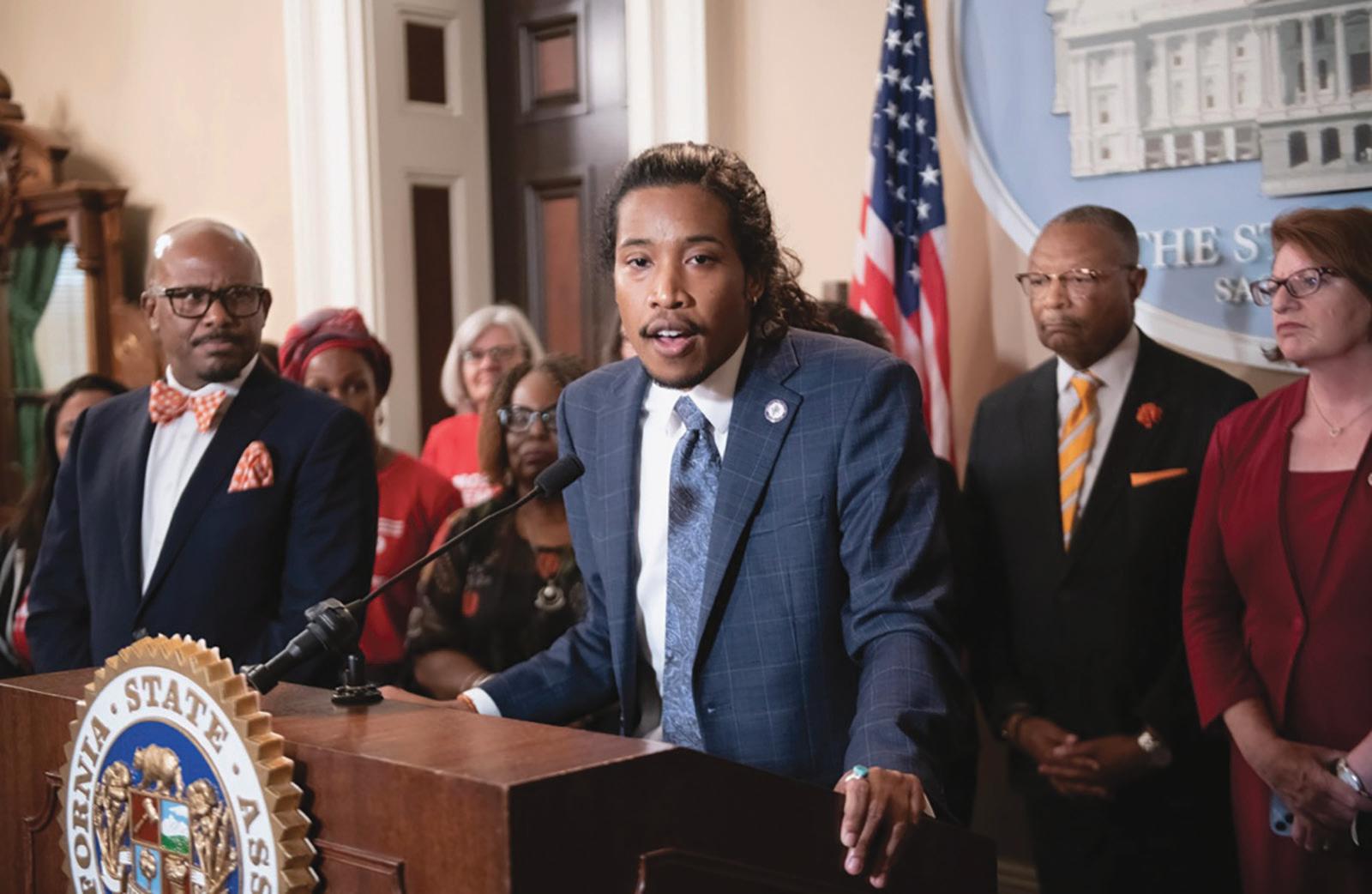
The visit occurred one month after Jones was expelled from the Tennessee legislature for participating in a protest on the Tennessee State House floor demanding urgent action on gun control. Jones has since been reinstated, and was recognized on the California Assembly floor with a resolution condemning his expulsion and that of fellow Black Democrat Justin J. Pearson by the Tennessee Legislature.
Jones told a roomful of reporters at the Capitol that he participated in the demonstration to “protect kids, not guns.”
“They tried to make a public spectacle out of us,” Jones said of the Republican lawmakers who voted to expel him.
“But what they didn’t realize is that the nation was watching, and that the nation was seeing the immoral decision being made to expel lawmakers instead of passing common-sense gun laws that the majority of Tennesseans, the majority of Americans, are calling for in this moment,” he added.
Sen. Steven Bradford (D-Inglewood) and Assemblymembers Tina McKinnor (D- Inglewood), Reggie Jones-Sawyer (D-Los Angeles) and Chris Holden (D-Pasadena) – all CLBC members -- attended the event. Senate President pro Tempore, Toni Atkins (D-San Diego) stood with Jones and the other lawmakers.
“I’m thinking about all of us are standing here united from the Tennessee State House to the California State House with a clear message that if you come for one of us you come for all of us,” Jones said. “This is what multi-racial democracy looks like and we will not let any type of authoritarian, anti-democratic force take us back in our history, a time we don’t want to go to.”
The Assembly unanimously voted 60-0 to disapprove of the actions taken by the Republican controlled Tennessee House chamber. The resolution, AJR 5, was authored by Assemblymember Mike Gipson (D-Gardena), who has authored and supported several other pieces of gun-control legislation.
Assembly Republican Minority Leader James Gallagher (R-Yuba City) praised Jones for speaking up on behalf of his constituents in Tennessee and pledged his full support for AJR
5. However, he also criticized his Democratic colleagues for not bringing wildfire prevention and anti-Fentanyl bills to the Assembly floor.
Gallagher said he was close to bringing “a megaphone” and coming onto the floor” to discuss those issues, which he said are priorities for his caucus.
“Don’t get up here and preach to me about democracy and talk about other states. The message about Rep. Jones is not just about Tennessee. It’s for you,” Gallagher said. “The bottom line is, if we want to ensure democracy, we better do it right here at home. Do a little soul-searching first before you make this into a day of the panderer.”
Gipson said gun control is an important issue that must be addressed in California and across the country due to the increasing frequency of mass shootings around the nation.
“Tennessee tried to snuff out democracy. Tried to silence the voices of the representatives that represent their constituency. If we stood by as Californians and did nothing, we would have been guilty of remaining silent about the things that matter,” Gipson said.
On April 6, the Republican-controlled state House held separate votes to expel Johnson, Pearson, and Jones from their elected positions for joining in a youth-led protest.
While Jones and Pearson were expelled, Johnson, who is White, narrowly avoided expulsion by one vote. A week later, Jones and Pearson were unanimously reinstated by the Nashville Metro Council and Shelby County Commission respectively.
Born in Oakland, Jones earned a Bachelor of Art degree in political science from Fisk University, a Historical Black College and University (HBCU) in Nashville. He has worked as an activist and a fellow for the John Lewis Center for Social Justice and he served on the board of directors of the Tennessee Healthcare Campaign. Jones was elected to his position representing Tennessee
House District 52 in the general election held on Nov. 8, 2022.
During the news conference, Gipson said Assemblymember Mia Bonta (D-Alameda) was “responsible” for bringing Jones to the State Capitol, along with other advocates against gun violence from Northern California.
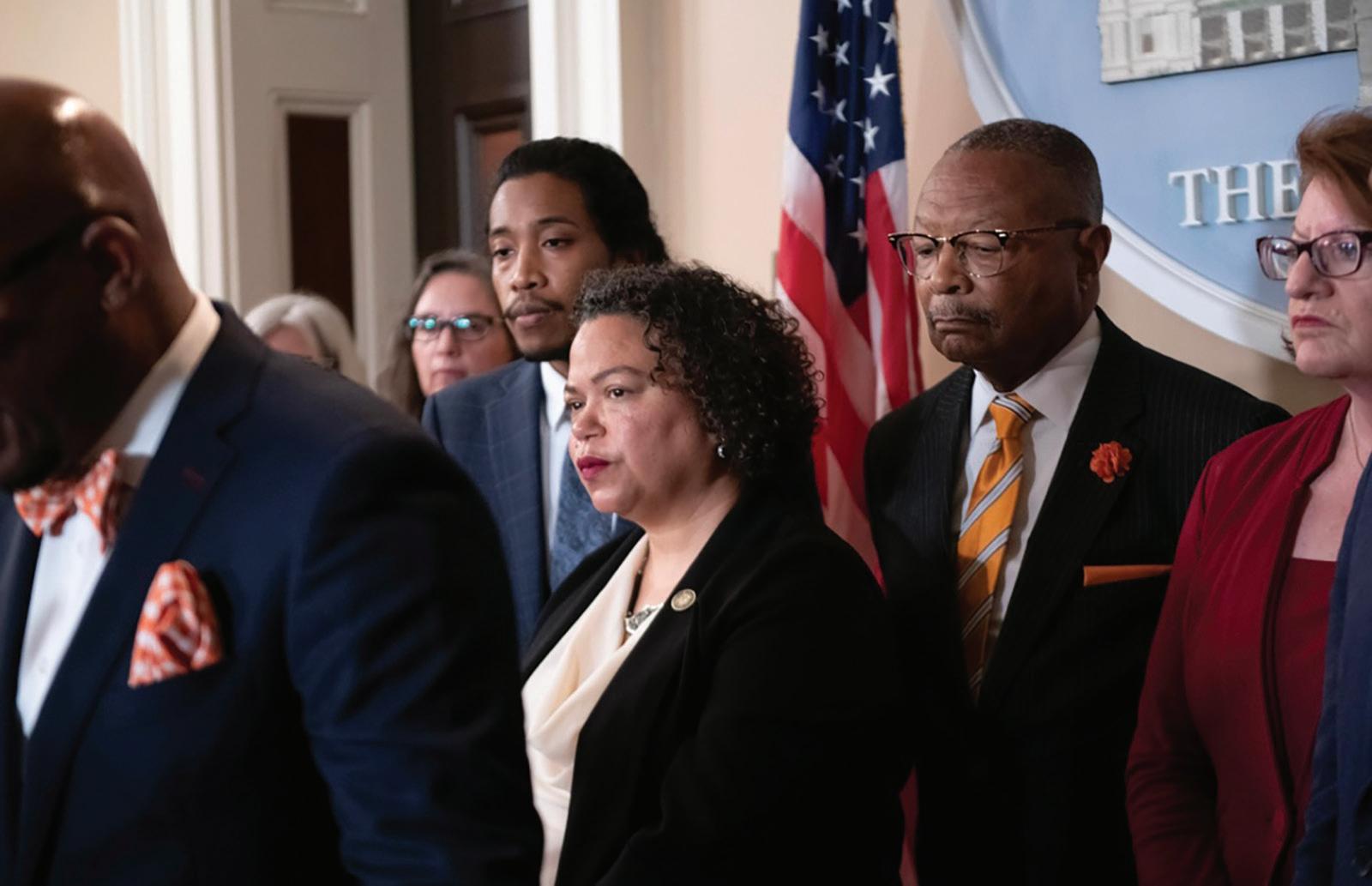
Bonta said she was both “inspired” by Jones and “heartbroken” to discuss the issue of gun violence.
Bonta added that protecting Democracy and supporting Jones and his Tennessee colleagues was imperative to saving lives.
“We needed to make sure that brother Jones and brother Pearson knew that while they are fighting this battle without the kind of support they need in the state of Tennessee that California will have their backs (and) Oakland will have their backs. Son of Oakland: we’re with you every single day,” Bonta said.
Tennessee Rep. Justin Jones visited the California State Capitol to discuss his experience of being expelled as a lawmaker for supporting constituents who ask for gun control. A few members of the California Legislative Black Caucus attended the news conference to show their support for Jones and resolution, AJR 5, authored by CLBC member, Assemblyman Mike
Tennessee Rep. Justin Jones (D-Nashville), displays a Black Power fist before walking on the California Assembly floor at the State Capitol in Sacramento on May 15, 2023. Jones, a native of Oakland, Calif., was briefly expelled from the Tennessee House of Representatives from joining a protest on the floor addressing stricter gun laws in the state. (CBM photo by Robert Maryland)
After the tragic shooting at Covenant School in Nashville that resulted in the loss of three children and three adults, Democratic Representatives Gloria Johnson, Pearson, and Jones joined a group of protesters at the state capitol. These legislators, whose districts are in Memphis, Knoxville, and Nashville - the state’s three largest cities - have been dubbed the ‘Tennessee Three’ by the media.
Angeles
News Observer Los
Adjudicated a Newspaper of General Circulation on July 2, 1991, Los Angeles Superior Court Decree, Case No. BS007262, Government Code 6023.
Bulk Mailing Permit 724 Bakersfield, CA 93385
Published every Thursday by The Observer Group Newspapers of Southern California, Inc.
Member: National Newspaper Publishers Assc.
Associated Press, Better Business Bureau, GLAAACC
President: Ellen Coley
CEO: Jon Coley
Publisher/ Editor: James Luckey Jr.
Operations Manager: James Luckey
Credo - The Black Press believes that America can best lead the world away from racial and national antagonisms when it accounts to every person, regardless of race, color, or creed full human and legal rights. Hating no person, fearing no person, the Black Press strives to help every person in the firm belief that all are hurt as long as any one is held back.
The Observer Group Newspapers reserves the right to publish views and opinions that may not necessarily reflect those of the staff and management are soleley the product of the responsible individuals who submit commentaries published in these newspapers. Letters, articles and comments appearing in the Observer Newspapers reflect the opinions of the contributor and do not constitute the opinion or endorsement by The Observer Newspapers or its staff. The Observer Group Newspapers assumes no responsibility for photographs, articles, letters, press releases and unsolicited materials. Decisions as to the editiing and publishing of materials are at the discretion of the Publisher and Editors. All rights are reserved on materials accepted for publication unless otherwise specified.
The Observer Group Newspapers of Southern California, Inc.: Los Angeles News Observer, Los Angeles News Observer, The Valley’s News Observer Los Angeles News Observer 6060 Center Drive Floor 10, Los Angeles, CA 90045 Mailing Address: PO Box 2341, Bakersfield, Ca. 93303 Phone (661) 324-9466 FAX
(661) 324-9472
General Info: observernews@gmail.com
Advertising: observeradvertising@gmail.com
Online: www.ognsc.com
Sen. Steven Bradford (D-Gardena), left, gives Tennessee Rep. Justin Jones (D-Nashville), right, a solidarity fist bump at the California State Capitol on May 15, 2023. Jones, a native of Oakland, Calif., was briefly expelled from the Tennessee House of Representatives from joining a protest on the floor addressing stricter gun laws in the state. (CBM photo by Robert Maryland)
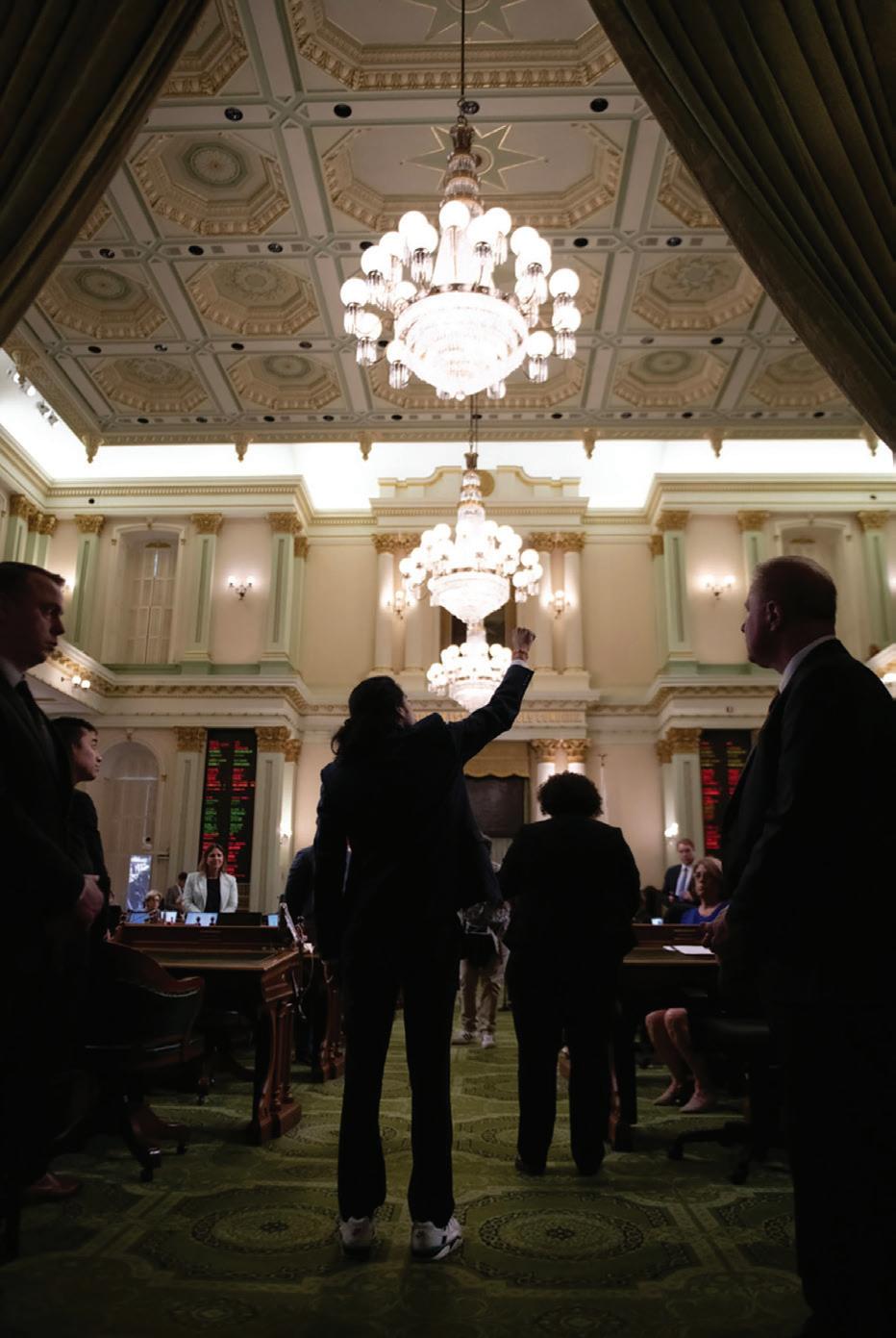
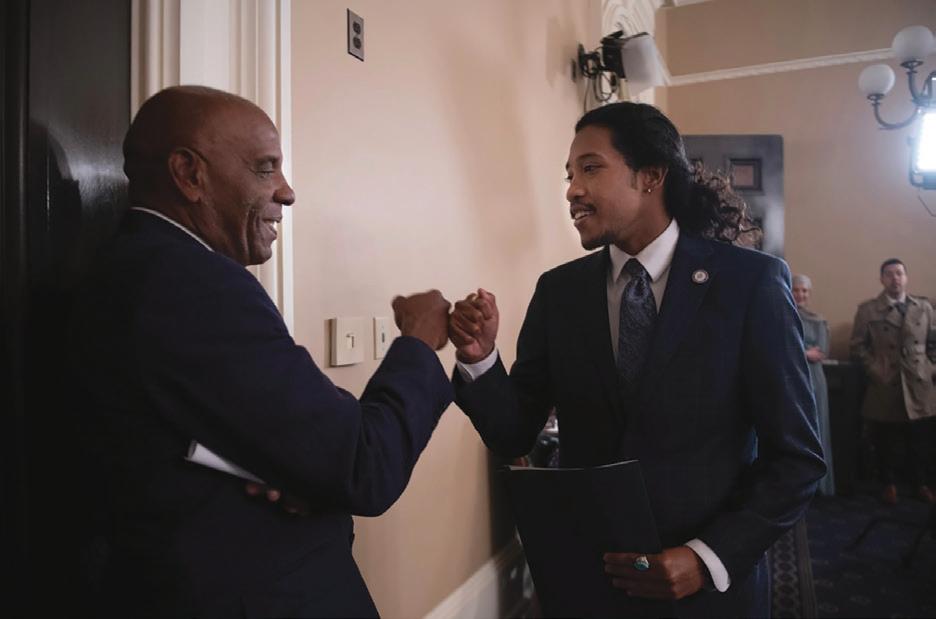
Assemblywoman Mia Bonta (D-Alameda) was partly responsible for Tennessee Rep. Justin Jones (D-Nashville) visit to the State Capitol on May 15, 2023. Jones is from Oakland, Calif., but attended and graduated from Fisk University, an HBCU in Nashville. (CBM photo by Robert Maryland)
CNN Employees and Republicans Panned Trump’s Disastrous Town Hall
By Stacy M. Brown NNPANewswire Senior National Correspondent
For some Republicans, Democrats, and journalists, CNN’s disastrous 70-minute town hall with Donald Trump proved what everyone thought it would be: a desperate network featuring a twice-impeached, criminally indicted wannabe despot.
The Trump presidential campaign rally, poorly disguised as a town hall, even received criticism from CNN’s own journalists.
“It was an interesting night,” longtime CNN anchor Jake Tapper observed.
“Trump’s first lie was told just seconds into the night with his false, familiar claim that the 2020 election was, quote, a rigged election.’”

Tapper wasn’t finished with his criticism.
“And the falsehoods kept coming, fast and furious, about the January 6 insurrection, about the threat to Vice President Pence, about Pence’s ability to overturn the election, about COVID, about the economy, and more,” he railed.
The cable network’s media reporter, Oliver Darcy, proved equally disturbed.
“It’s hard to see how America was served by the spectacle of lies that aired on CNN Wednesday evening,” Darcy wrote.
For his part, Trump was as bombastic and dishonest as ever.
He claimed that his long-promised wall on the southern U.S. border was complete, although evidence and the naked eye proved him wrong long ago.
In addition to reaffirming the Big Lie that the 2020 election was rigged, Trump declared that he would pardon many of the convicted rioters who bombarded the U.S. Capitol on January 6, 2021. Despite the violence and the vows of some insurrectionists
to hang former Vice President, Mike Pence, Trump incredulously said during the town hall that Pence was never in danger.
With Fulton County, Georgia, District Attorney Fani Willis poised to level charges against Trump for trying to influence the outcome of the 2020 election in the Peach State, Trump doubled down on his false contentions.
He even offered a defense to pressuring the secretary of state to “find” him more votes.
“Yeah, I called questioning the election,” Trump stated. “I said, ‘You owe me votes because the election was rigged.’”
Still, CNN released a statement praising the town hall’s host, Kaitlan Collins, for her “tough, fair, and revealing questions.”
“That is CNN’s role and responsibility: to get answers and hold the powerful to account,” the statement continued.
MSNBC host Joe Scarborough, once a close friend of Trump, called the program “a disgraceful performance.”
“I’m constantly telling people not to catastrophize over Trump that he’s actually going to lose because he keeps drilling down deeper and deeper into his base,” Scarborough railed.
“It was disgraceful on every level,” Scarborough added.
“It showed—I wouldn’t say it’s dangerous for democracy because we passed that a long time ago — but it showed the corrosive effects of Trumpism over eight years.”
He continued:
“The most shocking part was an audience who cheered on a president who tried to overturn American democracy, an audience that mocked and ridiculed the woman who a jury of her peers, Donald Trump’s peers, found had been sexually assaulted.
“Those Americans, their last night turned that into a punchline, laughed and dismissed. Cops getting the shit kicked out of them.
“On January 6. Beaten up over and over again, calling a cop a thug who actually was trying to stop people from the House floor from being killed. I could go. I just could go on and on, basically saying he would turn over Ukraine to Vladimir Putin.”
Some Republicans also criticized the town hall.
Republican Matt Whitlock, who worked for the late Sen. Orrin Hatch (R-UT), said in a tweet that “Trump’s performance tonight had plenty of fun fodder for his biggest fans,” but it was “toxic nuclear waste for the moderates and independents he (and Republicans everywhere) should be winning as Biden collapses.” According to Mediaite.com, Republican political consultant Ryan Girdusky predicted that Trump would lose the 2024 election.
“Ten minutes into the CNN town hall, and it’s all January 6 and the stolen election,” Girdusky wrote on Twitter.
“This election is gonna be all about Trump and he’s gonna lose… again.”
“If Kaitlan Collins wanted to actually embarrass Trump in front of his voters she would talk about him never building the wall, shutting down the economy, and rising crime while he was president,” Girdusky said.
The series examines Williams’s most memorable Grand Slam tournaments and formative life moments.
Serena Williams Documentary in the Works at ESPN
By Stacy M. BrownNNPA
Newswire Senior National CorrespondentSerena Williams has announced the start of production on her new ESPN series, In the Arena: Serena Williams.
Williams ruled tennis for over 20 years, winning 23 Grand Slams (singles). Like the Emmy-winning Man in the Arena: Tom Brady, the Serena Williams installment of the franchise reportedly will be a multi-part series that features first-person perspective from Serena and key figures throughout her life to “provide the most complete, intimate, and compelling account of her legendary career.”

The series examines Williams’s most memorable Grand Slam tournaments and formative life moments.
It contrasts Williams’s triumphant professional career and cultural significance with her private struggles, including her
Legendary NFL, Movie Star and Activist Jim Brown Dies at 87

Brown’s popularity grew, and he cemented himself into film lore, becoming the first Black man to have onscreen sexual relations with a white woman, Raquel Welch, in the film “100 Rifles.”
Brown was born on St. Simons Island, off the southern coast of Georgia, where he had a difficult childhood, according to biography.com.
Brown was only two weeks old when his father abandoned the family; Brown’s mother left him alone after she took a job in New York as a maid.
While living with his grandmother, Brown’s mother sent for him when he was 8.
During his senior year at New York’s Manhasset High School, Brown played running back and recorded a mindboggling 14.9 yards per carry, more than good enough to earn him a spot at Syracuse University.
In college, Brown dominated the competition on the football field and the basketball court.
He also ran track and was a talented lacrosse player, according to biography.com.
Brown earned national attention as a running back for his strong, explosive play. In the final regular-season game of his senior year, Brown capped off his college career by rushing for 197 yards, scoring six touchdowns, and kicking seven extra points.
In 1957, the Cleveland Browns selected Brown as the sixth overall pick in the National Football League draft.
“Brown wasted little time adjusting to the new competition, leading the league in rushing yards with 942 on his way to capturing the league’s Rookie of the Year honors,” his biographers wrote.
“Over the next seven seasons, Brown became the standard-bearer for all NFL running backs,” Brown’s
biographers continued.
At a time when defenses were geared toward stopping the ground game, Brown bulldozed his way past the opposition, posting remarkable season totals: 1,527 yards (1958), 1,329 (1959), 1,257 (1960), 1,408 (1961), 1,863 (1963), 1,446 (1964), and 1,544 (1965). His only “down” year came in 1962, when Brown rushed for 996 yards. It was the one season in his brilliant but brief football career where he failed to lead the league in yards. In 1964, Brown steered Cleveland to the NFL championship, where the club routed Baltimore 27-0 to win the title.
In the game, Brown ran for 114 yards.
“But Brown saw a life for himself outside of football, and before the start of the 1966 season, he stunned the sports world by announcing his retirement,” the biographers wrote, noting that Brown earned induction into the Pro Football Hall of Fame in 1971.
Brown appeared in over 30 films, including The Dirty Dozen (1967) and 100 Rifles (1969). His later credits include parts in Mars Attacks! (1996) and Any Given Sunday (1999), in which he played a football coach. “The National Newspaper Publishers Association (NNPA) is deeply sadden about the passing Jim Brown who was one of Black America’s enduring heroes on the football field and in the terrain of the Civil Rights Movement as a gallant freedom fighter for justice and equality,” NNPA President and CEO Dr. Benjamin F. Chavis Jr. stated. “We acknowledge and salute the outstanding contributions of Jim Brown that have made our world a better place for all of humanity.”
battle to keep her tennis career on top while adjusting to the lifealtering event of having a baby.
The Walt Disney Company said a new generation of competitors, eager to emulate Williams’ success and ultimately defeat her, marks a full circle in her career.
The series revisits the superstar’s defining matches, formative moments, heartbreak, and glory to trace her personal and generational journey from phenom to icon across her whole career and into her legacy.
ESPN, Religion of Sports, 199 Productions (under the direction of Tom Brady), and Nine Two Six Productions (under the direction of Williams and Caroline Currier) will all produce the series, which Gotham Chopra will direct.
The Walt Disney Company said it would provide more information later.
To Love You: Donna Summer’
Directed by Oscar-winning filmmaker Roger Ross Williams (The Apollo) and Brooklyn Sudano, the singer’s daughter, Love to Love You: Donna Summer arrives on HBO Max after making its premiere at the 73rd Berlin International Film Festival and at South by Southwest. Named for one of her biggest and most enduring hits, the doc explores Summer’s early life, her 1970s arrival as “The Queen of Disco,” and how stardom put new demands on someone who was by nature extremely private. The life and music of Summer, who passed away in 2012, was most recently celebrated on Broadway with Summer: The Donna Summer Musical, which ran for almost 300 performances.
The Gist: In 1975, the world fell in love with the sound of Donna Summer having fun. “Love to Love You,” which she co-wrote with songwriters and producers Giorgio Moroder and Pete Bellotte, was a slow-burn disco jam defined by Summer’s vocals and overt sensual moans; it became her first international hit, and set up her ascendance as “The Queen of Disco.” (The incandescent disco grooves of “I Feel Love” and “Last Dance” would soon follow.) But as Love to Love You: Donna Summer emphasizes, it was a success somewhat at odds with how the singer saw herself. “‘Love to Love You’ was becoming this world symbol of freedom and liberation,” Summer says in a recording heard in the doc. “Things would begin to happen. People would rip their clothes off and throw them on stage – bras, underwear – and I didn’t know, like, it was gonna be that racy.” An innate understanding was formed, where The Queen of Disco was a role, and Donna Summer was just a person.
“A lot of her life revolved around privacy and secrecy,” Brooklyn Sudano says in Love to Love. And Sudano, who directs
here alongside Roger Ross Williams, is seen making phone calls to the people who knew her mother professionally and probing her two sisters and other family members for a sense of the person behind the star. Born Donna Adrian Gaines in Boston in 1948, Summer’s talent as a singer was manifested in church before she lit off to New York City in the late 60s, singing in a blues band (Janis Joplin was an influence) before eventually landing in Munich at age 19 for a major role in a production of Hair. Donna Summer became a star in Germany, the collabs with Moroder and Bellotte followed, and soon it was time for America to greet its new disco queen. But as Sudano says, “Mom was complicated. She struggled with her fame, her image, even love.”
Love to Love utilizes a broad cross-section of archival footage to tell its story. Summer was omnipresent in the late 70s – she is seen in vibrant performance both in Europe and America, being disarmingly charming on Johnny Carson and The Merv Griffin Show, and making glamorous appearances at record release parties and award shows, flashbulbs popping and paparazzi trailing her limousine. But the doc also includes rare home movie footage shot by Summer herself, much of which plays against her public persona in revealing a natural quirkiness and mischief-making sense of humor. And as they sift through career mementos and their own memories, Brooklyn Sudano and Bruce Sudano, Summer’s collaborator and husband for over thirty years, reckon with the woman the world knew versus the mother and wife they loved. What Movies Will It Remind You Of? There are parallels in the lives and long careers of Donna Summer and Dionne Warwick, as Love to Love You and the recent Don’t Make Me
Over make clear. (Warwick appears briefly in Love to Love, presenting an award to Summer.) And like Love to Love, the recent music docs The Bee Gees: How Can You Mend A Broken Heart and The Velvet Underground benefit mightily from access to Universal Music Group’s vast copyright and catalog holdings.
Performance Worth Watching: Songs like “Love to Love You” and “I Feel Love” came to define not only Donna Summer’s career but a cultural moment, and that’s explored here from the doc’s title, through its stirring opening sequence, and on to a collection of fantastic color footage shot at New York’s Studio 54, where the inclusive club scene was driven into new states of euphoria. “I remember when ‘I Feel Love’ came on at Studio 54,” Elton John says in Love to Love. “You just stopped in your tracks. ‘WHAT is this?’ People screamed. It just went on and on and on, and you didn’t want it to stop. It sounded like no other record.”
Memorable Dialogue: Throughout Love to Love, whether in media interviews or recordings personal to her family, Donna Summer stresses how her true self existed in the space between her private life and the performative aspect of her work. “I was always a comedian. I was always a clown. So becoming ‘Donna Summer,’ the character, I didn’t feel very sexy at the time, so I just assumed it as a role. This time that I spent away from home, away from the mindset that I grew up in, away from what should be, away from how I should be – is what has made me what I am.”
What do you think? Be the first to comment.
Sex and Skin: This doc is most interested in the discourse surrounding sex and sexuality in the 1970s, and how Donna Summer both accessed that conversation and felt continually apart from it. Included is an extended recording studio take of
the simulated sounds of pleasure in “Love to Love You.” But also included is home movie footage of a cartoon striptease, shot by Summer herself, where she assails the manufactured nature of her sexy persona to the howling delight of her friends off camera. Our Take: There’s a searching, at times somber quality to Love to Love You: Donna Summer. The superstar singer died in 2012 at 63 after a battle with lung cancer, and from the perspective of Brooklyn Sudano, there was perhaps not enough time to learn about how her mom saw herself once the glitter ball stopped turning. Sudano, her father Bruce, her two sisters, and her mom’s siblings all admit a certain detachment from Summer and the emotions she kept private; it is said that her most raw moment of vulnerability only arrived in the days before her untimely death. And in that sense, the recurring close-up of Donna Summer’s eyes in Love to Love – it’s a piece of footage from around 1975; she’s waiting for direction from someone off-camera during a video shoot – becomes a valuable tool for illustrating the singer’s inner life, and how it existed concurrently with her popular emergence. For viewers, the doc is revealing as a biography, as well as a sound exploration of celebrity as it existed in a previous era. But just as often, Love to Love You: Donna Summer feels made for the family themselves, as a means of finally, truly seeing into the woman who they adored but always knew kept herself to herself.
Love to Love You: Donna Summer is a music doc as oral history, crafted and told by the folks who knew its subject best while still longing to know more. But it also tracks the mechanisms of starmaking, the highs and lows of which really haven’t changed that much in the five decades since Summer was first crowned the “Queen of Disco.”

‘Love
on HBO Max, A Sensitive Doc Exploring the Public and Private Selves Of The Queen Of Disco
New Study Reveals Excess Mortality and Years of Potential Life Lost Among the Black Population in the US from 1999-2020
Senior National CorrespondentA new study shows that after some progress, the number of deaths and years of possible life lost among America’s Black population stopped going down and then started going up again.
The Journal of the American Medical Association (JAMA) said their results show that new ways of doing things are needed.
JAMA looked at statistics from the Centers for Disease Control and Prevention (CDC), which showed that when the coronavirus pandemic hit the world in 2020, the number of deaths and years of potential life lost went up. Compared to white people, 1.63 million more Black people died than they should have.
Experts said that’s the equivalent of 80 million years of potential life during the study period, which took place from 1999 to 2020.
“After a period of progress in reducing disparities, improvements stopped, and differences between the Black population and the white population got worse in 2020,” JAMA experts wrote.
Because of the pandemic, experts stated that years of growth had ended.
They said the pandemic affected Black Americans more than other groups.
Herman Taylor, one of the study’s authors and head of the cardiovascular research institute at the Morehouse School of Medicine, said, “The study is very important for about 1.63 million reasons.”
Adolescent Health:
Promoting Access to Services, Open Communication, and Supportive Environments
By Nomsa Khalfani, Ph.D.It’s natural to want what’s best for your children and to witness the young people raised by or around you grow into healthy, thriving adults. But we all know from personal experience that adolescence can be a challenging time full of physical and emotional changes, peer pressure, and risky behavior.
As a parent and former social worker, I understand the importance of supporting youth during their challenging teenage years. I’ve seen and heard how difficult it can be to navigate this landscape, and today’s kids face even more obstacles than previous generations. From the rise of cyberbullying to the ongoing attack on sexual and reproductive rights, young people must deal with a range of issues that threaten their health and well-being— that’s where we step in.
Nomsa Khalfani, Ph.D., is Co-CEO of Essential Access Health, a non-profit organization that champions health equity and quality sexual and reproductive health care for all through a broad range of programs and services.
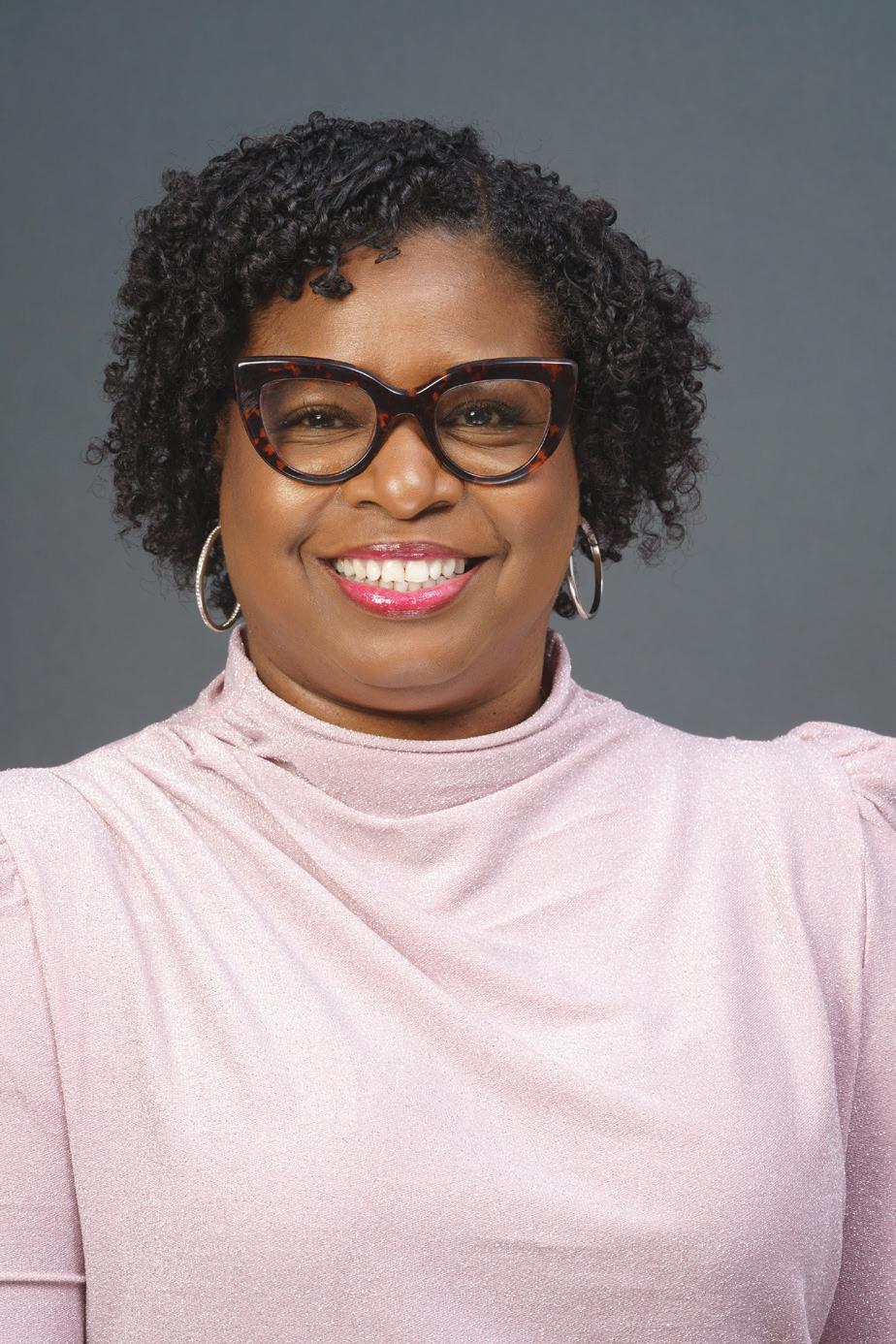
May is National Adolescent Health Month, an opportunity for adults to be advocates and allies, and acknowledge youth’s essential role in building our communities and shaping the future. It is critical that we, as parents and caregivers, prioritize their health by taking an active role in supporting them to make informed choices. Here are five ways we can provide the environment and support that young people need to achieve optimal health: Prioritize mental health
“Real lives are being lost. Real families are missing parents and grandparents,” Taylor declared.
“Babies and their mothers are dying. We have been screaming this message for decades.”
Clyde Yancy, an author of the study and chief of cardiology at Northwestern University’s Feinberg School of Medicine, told reporters that high death rates among Black people have less to do with their genes.
However, it has more to do with the country’s long history of discrimination, which has hurt generations of Black people’s chances of getting an education, a good place to live, and a good job.
Yancy said that Black areas redlined in the 1930s, meaning that mortgages and other investments were too “high risk” for them, are still poorer and sicker today.
Yancy remarked that there were also more COVID infections and deaths in ZIP codes that used to be redlined.
“It’s very clear that we have an uneven distribution of health,” Yancy said. “We’re talking about the freedom to be healthy.”
In 2021, non-Hispanic white Americans could expect to live to 76 years old, but non-Hispanic Black Americans could only hope to live to 71 years old.
A big reason for this difference is another study that showed that non-Hispanic Black babies are 2.5 times more likely to die before their first birthday than non-Hispanic white babies.
Non-Hispanic Black mothers are more than three times more likely to die from a pregnancy-related problem than non-Hispanic white moms.

white
Teens can feel misunderstood and dismissed when they try to express their internal struggles to adults, especially when told that they’re being dramatic or over-the-top as a response. We can break the stigma around mental health and show support by actively listening, reassuring them that their feelings are valid, and connecting them with counseling resources and mental health services.
Create a safe space to talk about sexual and reproductive health
Building relationships and creating comfortable environments can help encourage young people to ask questions and seek accurate information on sexual and reproductive health from adults they trust. According to TeenSource, an adolescent health and equity promotion program, over two-thirds of teens in focus groups reported never receiving “the talk” from parents or caregivers. Conversations about health should be ongoing discussions and go beyond the topic of the birds and the bees. It is also important to address topics such as consent, healthy relationships, body image, and diverse sexual identities and experiences.
Discuss and model consent
Consent is essential in all aspects of life, especially regarding sexual health and relationships. We must teach young people the importance of respecting boundaries, asking for consent, and being aware of power dynamics. As advocates of youth, we should set examples and model consent in our interactions with others to help them understand healthy relationships and what they should look like. Protect access to services and information
We must fight to ensure that teens have access to comprehensive sexual and reproductive health services and information, including contraception, sexually transmitted infection (STI) testing, and treatment. Moreover, we must equip them with the knowledge and skills to navigate the healthcare system and connect to care when needed. Programs like TeenSource help provide a safe space for young people to amplify their voices and seek answers to questions regarding care, sexual health, relationships, and other topics. To learn more, visit teensource.org
Promote health and safety if sexually active
Sexual activity is a natural part of adolescent development.
In addition to ensuring access to services and information, we can support youth in making informed decisions about sexual health by encouraging the use of condoms and other forms of contraception to prevent STIs and unintended pregnancies. We can also promote the importance and safety of the Human papillomavirus (HPV) vaccine to prevent cancer and other health problems that can impede their future.
Supporting adolescent health requires a community effort. We have a vital role in creating a supportive and empowering environment for teens. Let’s work together to ensure that all adolescents have the information, resources, and support they need to be healthy and thrive. For more information on how to communicate openly with youth, visit talkwithyourkids.org
Nomsa
California Black Media Political Playback: News You Might Have Missed
Tanu Henry and Edward Henderson California Black Media
Your roundup of stories you might have missed last week.
Sen. Lola Smallwood-Cuevas Is Leading Fight for Albertson’s Employees, Other Grocery Workers
Sen. Lola Smallwood-Cuevas (D-Ladera Heights), a member of the California Legislative Black Caucus, says she wants to protect workers who lose their jobs when there are mergers between grocery store chains.
In February, Smallwood-Cuevas introduced Senate Bill 725.
The bill would mandate that grocery store chains provide severance pay to workers laid off due to a merger or acquisition. The severance would be equal to “one week of pay for each full year of employment” if the employee is not retained for at least 90 days after a “change in control.”
Last week, workers unions, held a rally in support of SB 725 in Sacramento.
“I stood with grocery store workers who traveled to the State Capitol today to rally in support of a bill package that addresses the harmful effects of grocery mergers,” wrote the only Black woman Senator in the California Legislature on her Facebook page.
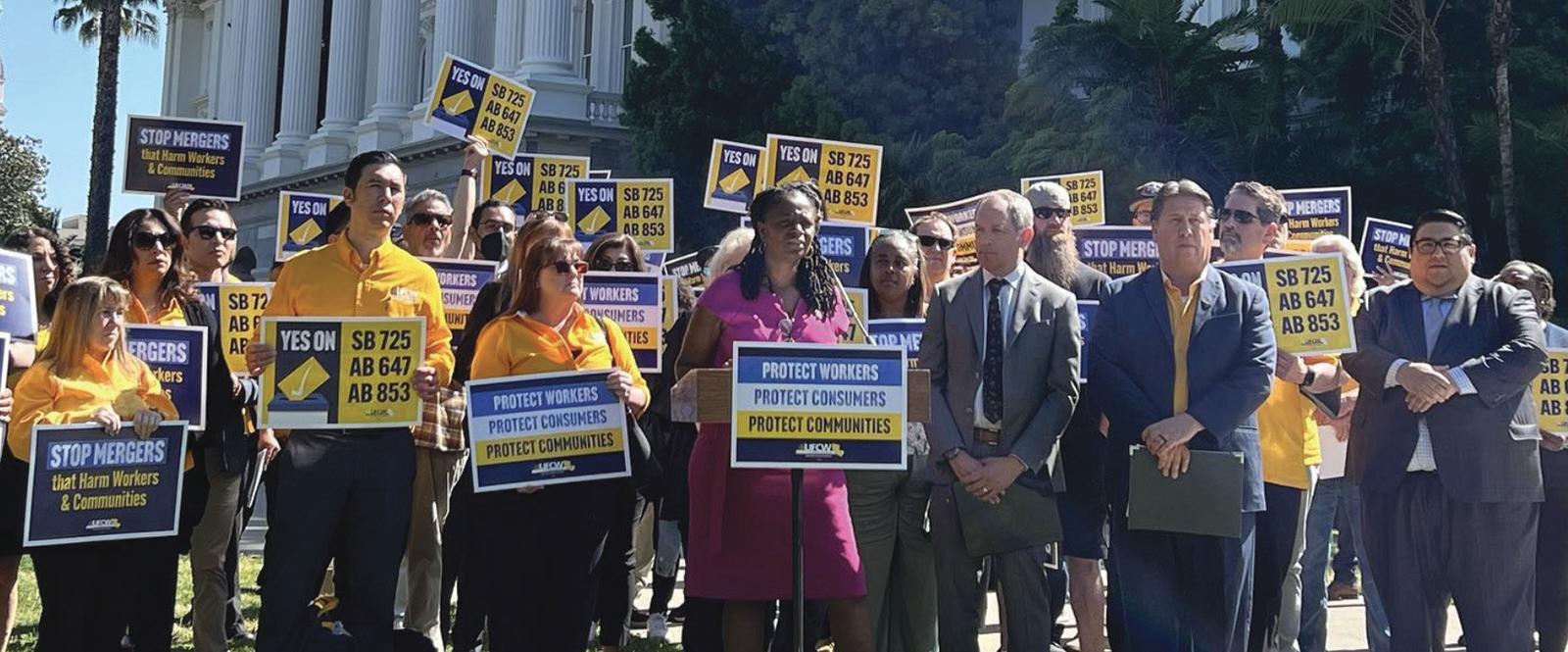
“This rally comes on the heels of a proposed deal between Albertson’s and Kroger – the nation’s two largest grocery store chains with an outsized presence in California – to ink a $24.6 billion merger.”
In April, the Senate Committee on Labor, Public Employment and Retirement voted 5-0 to advance the bill. It is now pending a third reading on the Senate Floor.
California Women in College Can Apply for Scholarships Up to $10,000 on Or Before May 31
The deadline to apply for a Women in California Leadership (WICL) scholarship for deserving women who are college students is May 31.
The WICL Minerva Scholarship program is offering up to 108 scholarships valued at $3,000 each to California residents who identify as women and are enrolled full-time in an accredited program with a GPA of 2.5 or above.
One fortunate student will be granted a $10,000 scholarship.
“Women have made considerable advances in the workforce in recent years, yet still face inequities preventing
them from taking part in said Assemblymember Tasha Boerner (D-Encinitas), a legislative champion of the program. “This scholarship opportunity helps break down a financial barrier to education in order for them to reach their full potential.”
WICL, a non-profit dedicated to raising awareness about issues critical to women in California, says the scholarship program “was established with the purpose of empowering women and enhancing the lives of women and girls.”
Fast Food Restaurant Owners Make Their Case in Sacramento
Last week, a group of fast-food restaurant owners, their supporters and advocates gathered at the State Capitol in Sacramento to oppose Assembly Bill (AB) 1228.
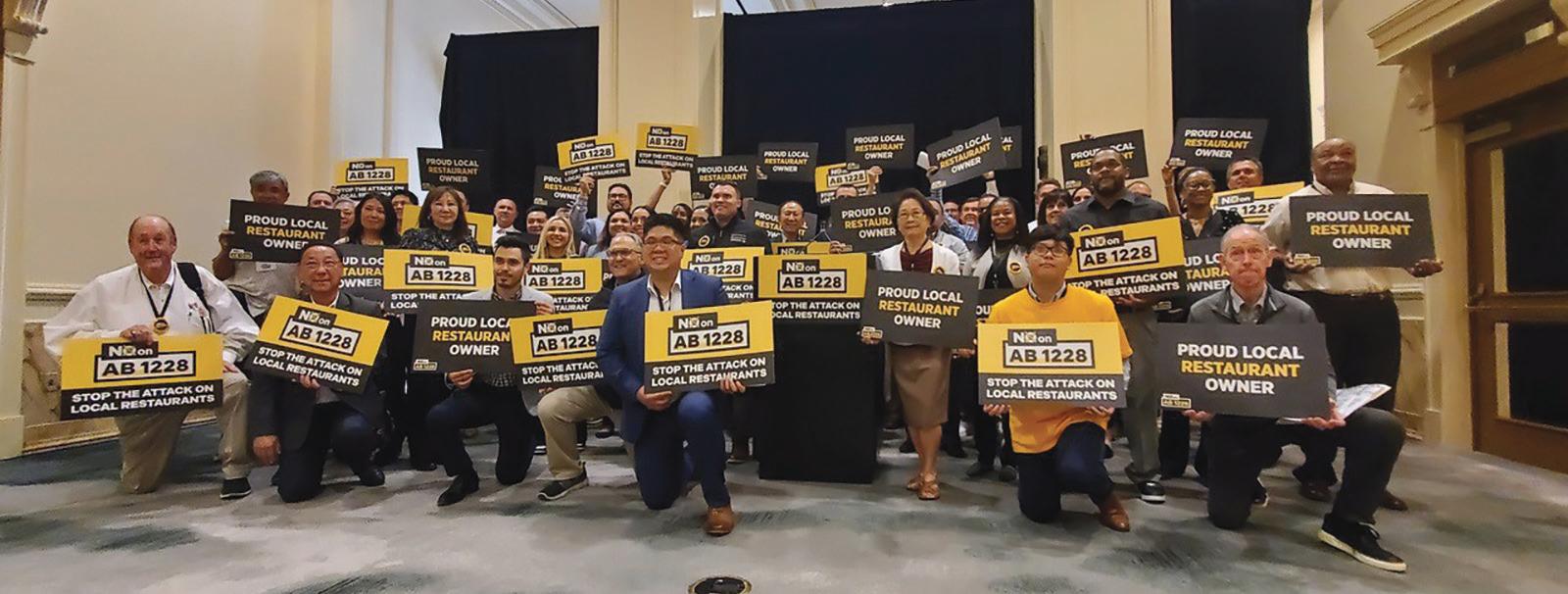
They believe the bill, which would require major fastfood businesses and franchisees to share legal responsibility for the franchisee’s workplace health and safety violations of California Labor Law, would harm their businesses.
The coalition’s rally at the State Capitol coincided with the launch of an ad campaign created to raise public awareness about the bill.

One ad the group released features Mat A., a Lake Elsinore restaurant owner.
“AB
1228 would force national fast-food corporations to take more control over local franchise restaurants, taking away the rights of local restaurant owners to run our own businesses. AB 1228 would destroy franchise businesses like mine,” he said.
California Coalition of Big City Mayors Hold Press Conference in Sacramento
Mayors from California’s 13 largest cities held a press conference in Sacramento last week. They urged Gov. Newsom and lawmakers to continue providing $2 billion per year in direct funding to for transitional and permanent housing and homelessness prevention programs. The mayors also requested the release of $316 million dollars in “bonus homelessness funding that is “available right now.”
At the event, the mayors released a report on the work they are doing to remove unhoused people from homelessness encampments to safe housing in their cities.
“These programs are working,” said San Diego Mayor Todd Gloria, chair of the California Big Cities Coalition.
“Our 13 cities have funded nearly 16,000 new shelter and interim housing beds. We’ve served more than 121,000 Californians and provided placements to nearly 20,000 people. Through Project Homekey with created more than 5100 new homes across the state.
Los Angeles Mayor Karen Bass said since she took
office her efforts have taken some 4000 Angelenos off the street but she can’t “do this work alone.”
“No mayor can do this work alone,” said Bass. “While this year’s state budget must be difficult, the need for housing interventions and services must remain a top priority.
Independent Legislative Analyst Office Respond’s to Gov. Newsom’s May Revise Budget
On May12, Governor Gavin Newsom presented his revised budget to the Legislature for review.
Last week, the Legislative Analyst’s Office (LAO) published a report providing commentary on the Governor’s proposed revisions and their effectiveness in solving California’s “budget problem.”
The budget problem the LAO is referring to is the state’s pending $31.5 billion-dollar deficit.
There were three key takeaways from the LAO’s report:
LAO estimates that with the Governor’s latest budget revision, the $28.3 billion budget problem was solved.
“Total budget solutions proposed in the May Revision (including those that persisted from the Governor’s budget) are: $15.1 billion in spending reductions and delays, $9.1 billion in cost shifts, $3.7 billion in revenue increases and shifts, and $450 million in reserve withdrawals,” the report highlighted.

Although revenues are always uncertain, the revision is predicated on optimistic estimates
“Based on our assessment, there is a roughly two-thirds chance revenues will come in below May Revision estimates. As such, while we consider the May Revision revenues plausible, adopting them would present considerable downside risk.”
Adopting these estimates sets up a difficult January 2024
“Under our revenues, and after accounting for constitutional spending requirements, the budget problem for 2023-24 is $6.2 billion larger than the administration’s estimates. The state currently has $11 billion in one-time or temporary spending planned for 2023-24 -- amounts that could be reduced to address this larger budget problem.”
The concern is that once the new fiscal year begins in July and state departments begin distributing funds, pullbacks would need to be based on what money has gone out the door instead of the state’s priorities.

Gavin Stone and Bobby Miller Make Strong Debuts for Dodgers
By Earl Heath Contributing Sports“It doesn’t matter how far the game may feel out of reach, our offense is dangerous,” said Martinez.
Writer

After losing three of four games in St. Louis and with injuries to Dustin May (forearm) and Julio Urías (hamstring), the Dodgers called up top pitching prospects Gavin Stone and Bobby Miller. Both rookies stepped up and got off to a good start, helping the Dodgers win two of three games against the Atlanta Braves.


Stone started the opener on Monday night and went four innings, allowing five hits and five earned runs. Evan Phillips came on in relief and pitched a scoreless fifth inning, and Caleb Ferguson followed with a scoreless sixth. Yency Almonte retired the top of the Atlanta lineup in order in the seventh, and Phil Bickford was replaced by Brusdar Graterol, who gave up an RBI double in the eighth. Graterol then returned in the ninth to get his third save of the year.
“We exhausted a lot tonight,” said Dodgers manager Dave Roberts. “But it feels good to win this one.”
Stone was helped by a three-run homer from Freddie Freeman, who also scored a pair of runs. J.D. Martinez went 4 for 5 with a pair of solo home runs.
The Dodgers trailed 4-0 after one inning, but they rallied to win 8-6.
The following night, it was Miller’s turn. The 24-year-old only had eight outings at Triple-A Oklahoma City before being called up to the big leagues.
Will Smith singled home Mookie Betts in the first inning to give the Dodgers a 1-0 lead. Miller allowed one run when Austin Riley doubled to left-center and Sean Murphy scored on an error by Miguel Rojas. That was it for scoring on the night.
With his family looking on, Miller went five innings, giving up just four hits, striking out five and walking one.
“As confident as I looked out there,” said Miller. “I was very nervous under that poker face. I just had to focus on my breathing and tell myself it’s the same game.”
Miller threw a season-high 76 pitches and reached 100 mph several times, even though he only threw 12 fastballs. According to Roberts, Miller will get another one or two starts.
“For him to arrive and pitch like he did on a stage like this against a team like this, the way he showed was really encouraging for all of us,” said Roberts. “I think this is just a start.”
The Dodgers’ two young pitchers gave the team a muchneeded boost after a tough series in St. Louis. With May and Urías still out, Stone and Miller could be called upon to play a big role in the Dodgers’ rotation for the rest of the season.
Lady Aztecs Headed to Super Regionals
By Earl Health Contributing Sports WriterThe San Diego State softball team homered three times to rally for a 6-3 victory over Liberty Sunday afternoon and claim the NCAA Los Angeles Regional at Easton Stadium. With the win, the Aztecs (38-15) advanced to their first NCAA Super Regionals in program history and will play at No. 15 overall seed Utah this weekend.
SDSU, the third-seeded team in the region, trailed the second-seeded Flames (40-22), 2-0, through three innings but scored the next six runs, thanks in part to home runs by Cali Decker, AJ Murphy and Jeweliana Perez.
San Diego State went 3-0 in the NCAA’s toughest regional (RPI average of 32.00), outscoring the opposition, 19-3. The Aztecs also improved to 6-0 in the postseason, also winning all three games at the Mountain West Tournament from May 11-13 at SDSU Softball Stadium.

LU struck first in the bottom of the first inning, banging out five hits, but only scoring two runs as SDSU’s defense recorded three outs on Liberty baserunners. Rachel Roupe had the Flames’ third straight single and leadoff hitter Devyn Howard rounded third and headed home. San Diego State center fielder Macey Keester relayed the ball to shortstop Jillian Celis, who threw it home to Decker, who applied the tag for the first out of the inning. Rachel Craine singled to load the bases and Megan Fortner followed with a double to score two runs. The Aztecs, however, were able to get Craine out at third when Celis sneakily threw it to Murphy at third base for the tagout. With Sierra Kersten at the plate, Decker then picked off Fortner at second to get San Diego State out of the inning.
The Aztecs tied it in the top of the fourth as Celis singled and Decker followed with a home run over the left-field wall. It was her fourth homer over her last seven games and sixth of the season. SDSU then put the game away with four runs in the sixth, including a two-run homer by Murphy and a solo home run by Perez. It was Murphy’s fifth homer of the season and the second by Perez. San Diego State scored its first run in the inning when Celis scored after a double when Craine at first base let Decker’s hard-hit ball go through her legs.
After LU had five consecutive hits to start the game, the Aztecs outhit Liberty, 10-2, the rest of the way. Celis (2 R, 3B), Espinoza and Murphy (2 RBI, R) each had two hits apiece for SDSU. Pitcher Allie Light settled down after the five-hit, two-run first inning. Light (14-6), the MW Pitcher of the Year, allowed three runs on seven hits and no walks over 6 1/3 innings, striking out three. The Flames’ final run came on a solo homer by Fortner to lead off the seventh. Dee Dee Hernandez took over for Light with one out in the sixth and nobody on base and retired both batters she faced for her fifth save of the season.
ADD AZTECS: An old friend helping SDSU former
BRUIN Delanie Wisz will be in the doug out as an assistant coach, she earned Women’s College World Series All-Tournament Team honors in 2022, was a NFCA second team All-American
(2022), earned Softball America second team All-American (2022), was a D1 Softball second team All-American (2022), and was a two-time All-Pac-12 honoree (First Teamer).

New Legal Standards:
California Takes Steps to Crack Down on Housing Discrimination
Aldon Thomas Stiles California Black Media
Since the early 1990s, landlords and managers nationwide have partnered with law enforcement to implement “crime-free housing” policies. These policies aim to reduce criminal activities such as drug use and gang activity.
In California, crime-free housing has become increasingly controversial. Advocates and some state officials have been railing against these policies for being discriminatory.
On April 21, California Attorney General (AG) Rob Bonta announced new guidance for crime-free housing policies statewide, pointing out that the former rules disproportionately impacted “people of color, survivors of domestic violence, people with disabilities, and justiceinvolved individuals,” according to the press release from the Attorney General’s office.
“In California, we’re taking action to end housing discrimination and foster diverse communities,” stated Bonta.
“The statewide guidance issued today presents clear legal standards and procedures to proactively prevent discriminatory housing practices within localities,” Bonta continued. “Tenants have rights under the Fair Employment and Housing Act and other California laws that protect against many forms of housing discrimination, and this guide aims to ensure we are eliminating barriers to housing and promoting equal opportunities.”
Across California, 147 cities and counties have adopted revised policies aimed at eliminating discrimination, including some of the state’s most populated cities like Long Beach, Los Angeles, Oakland and Sacramento.
The California Department of Justice is encouraging all municipalities in the state to reevaluate their crime-free housing policies, invoking civil rights laws and fair housing regulations.
“I recognize that leaders at the local level are on the front lines of ensuring public safety for their residents, and, separately, that California law provides discretion to local jurisdictions to enact and enforce nuisance laws that are non-
discriminatory and otherwise consistent with California law,” Bonta stated in a letter to California’s cities and counties.
“Regardless of when these policies were adopted, local
jurisdictions have the responsibility to ensure that they comport with state and federal law, and not to implement or enforce them in a discriminatory manner,” he continued.
While there are various types of these programs across the state, most are designed to give landlords a way to deny or evict tenants who have had some interaction with the criminal justice system.
In some cases, landlords do not need a conviction or an arrest to activate these policies.
According to the website of the Murrieta police department – a town of about 100,000 people in Riverside County – crime-free housing helps law enforcement manage criminal activity.
“The police cannot solve crime problems alone,” the website reads. “Neither can the management or residents of rental properties. However, by working together, the end result has been the most successful approach to crimes in rental communities.”
AG Bonta isn’t the only state official with concerns about the alleged discriminatory nature of crime-free housing policies.
Assembly Bill (AB) 1418, introduced by Assemblymember Tina McKinnor (D-Inglewood), would prohibit crime-free housing policies statewide.
“Every Californian wants to live in a safe neighborhood, yet for too many years, ‘crime-free’ housing policies have not reduced crime, increased housing availability or increased housing affordability,” McKinnor stated in a press release. “AB 1418 will end these harmful policies that have made it harder for Californians to find a safe place to call home and eliminate laws that have resulted in further housing segregation across the state.”
This bill was first introduced in February and is currently in committee.
The U.S. Department of Housing and Urban Development (HUD) states that even if a policy appears neutral, it may still violate the law if it has “discriminatory effects” without a reasonable and legal justification.
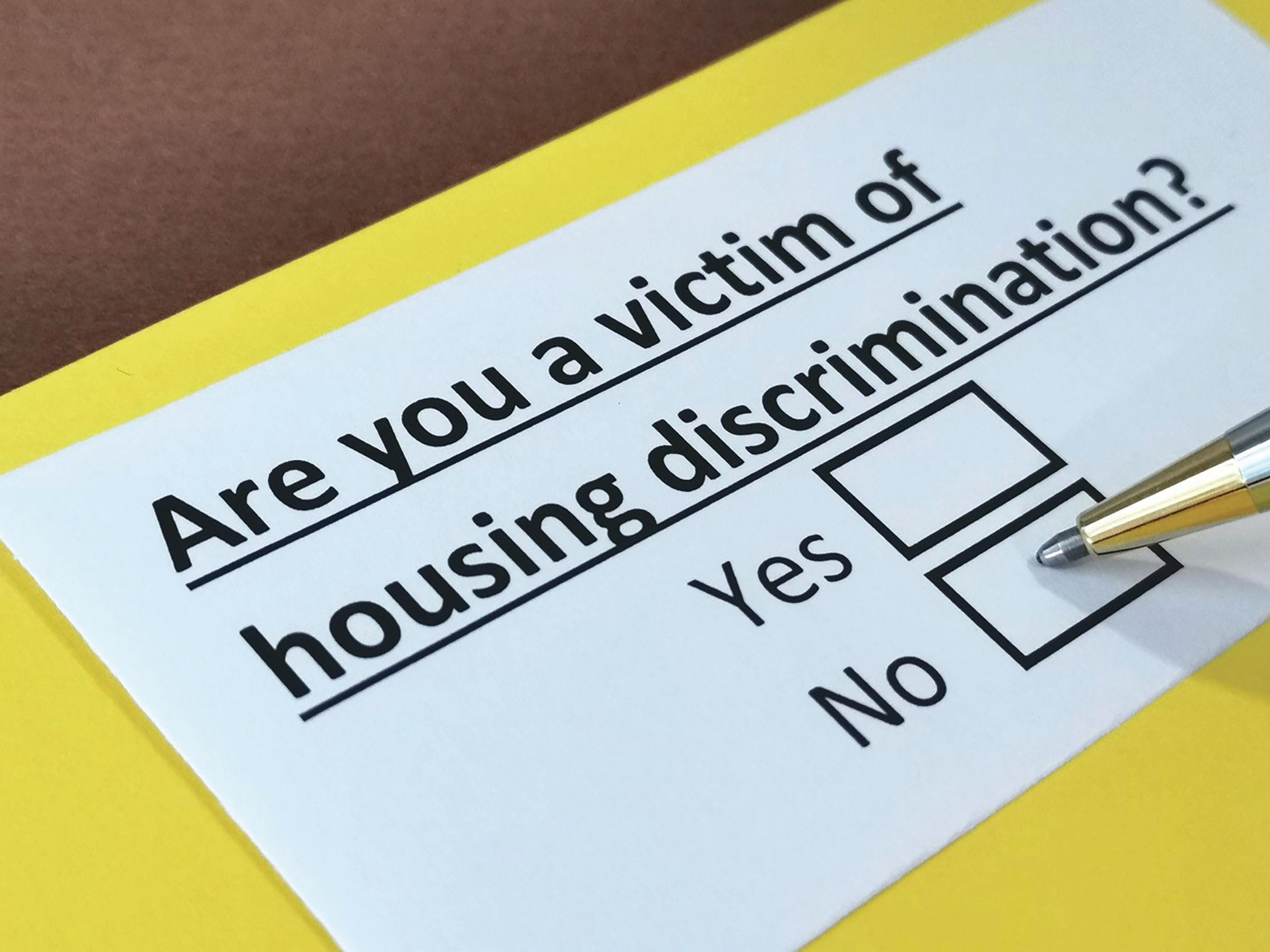
According to the Attorney General’s office, these regulations must apply to California state law.
Last December, the U.S. Department of Justice secured its first settlement banning crime-free housing in San Bernardino County and Hesperia.
This agreement requires San Bernardino County and the city of Hesperia to spend about $1 million, mostly to compensate residents and tenants negatively impacted by crime-free policies.
Legislators, Advocates Grapple with Bill Decriminalizing Psychedelics
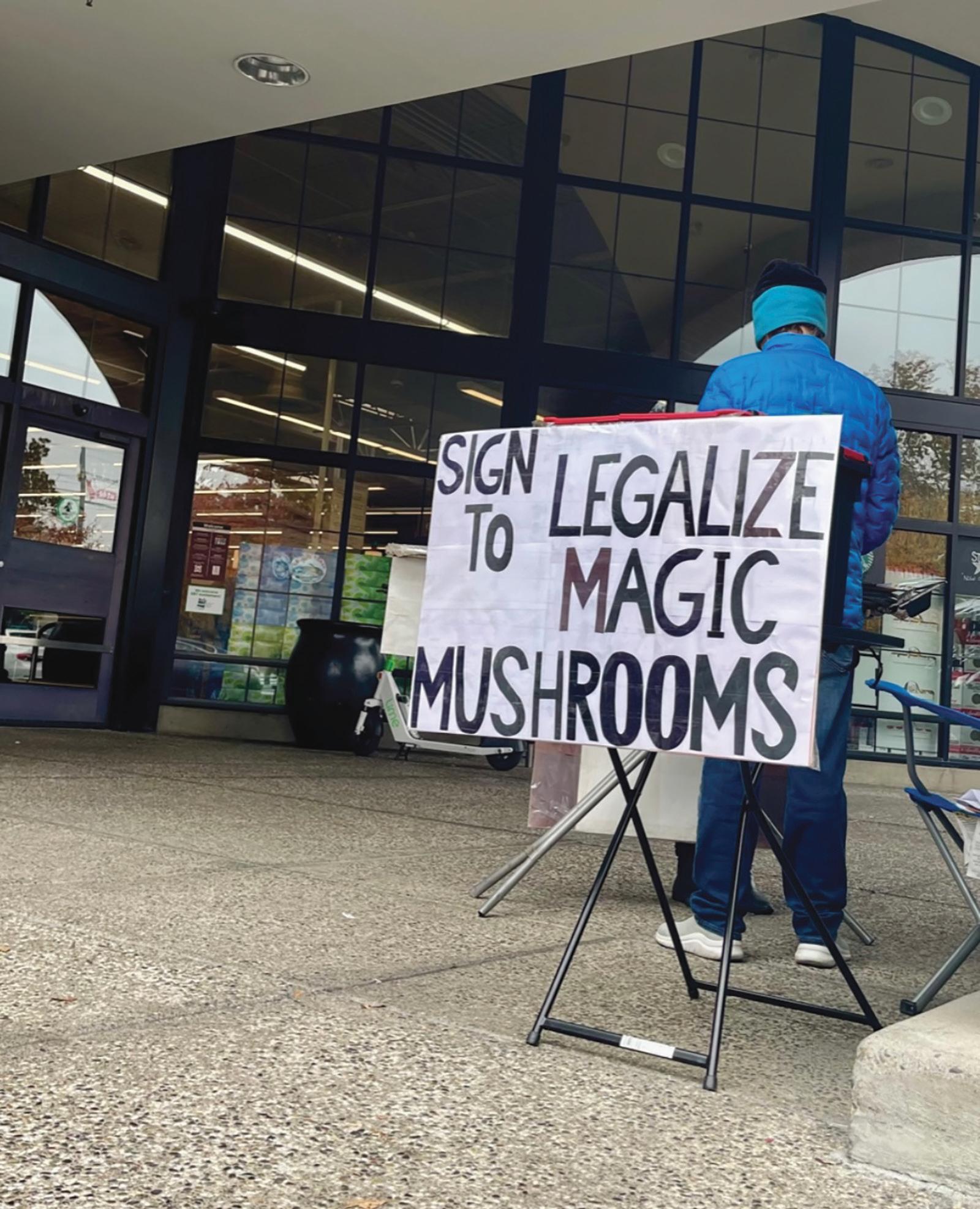
Maxim Elramsisy California Black Media
“I’m here today to tell you that psychedelic medicines represent the single most profound and important breakthrough in the treatment of mental health in our lifetimes,” said Dr. Nathaniel Mills, a Sacramento-based clinical psychologist at a Senate Public Safety Committee hearing for Senate Bill (SB) 58.
“Never in my 19 years of clinic has somebody said to me, ‘Dr. Mills: SSRI (Selective serotonin reuptake inhibitors) changed my life,’ but I’ve lost count of the number of times that people have come into my office and said, ‘Dr. Mills: I recently had an experience with a psychedelic, and I think that I’m cured,’” he added.
SB 58 was authored by Sen. Scott Weiner (D-San Francisco) and co-authored by several leaders of the California Black Legislative Caucus (CLBC). It aims to decriminalize the possession and personal use of plant and fungus-based psychedelics such as psilocybin, psilocyn, dimethyltryptamine (“DMT”), mescaline, and ibogaine – drugs that can cause temporary changes in consciousness and perception.
“These substances, in particular, are not addictive, and they show a lot of promise in helping people address mental health and addiction disorders,” Weiner said in an interview with California Black Media (CBM).
SB 58 has faced opposition from several organizations across the state, including law enforcement groups, the California District Attorneys Association (CDAA), and the California Contract Cities Association (CCCA).
“CDAA is concerned that making these drugs legal for recreational use, as opposed to strictly for research-related therapeutic use, is not grounded in scientific evidence about the dangers these drugs pose to individuals and communities,” read a statement from the group representing the state’s county prosecutors. The bill’s authors argue that the “war on drugs” negatively impacted communities, particularly communities of color. “If criminalizing drug use stopped people from using drugs, we would have zero drug use in this country,” said Weiner, during a Senate Public Safety Committee hearing in March. “This bill means that people will no longer be arrested and prosecuted simply for possessing or using these drugs. This is about simple possession and use of these psychedelic substances.”
“This is not legalization, and setting up a legal market,” Weiner said to CBM. “That might happen in the future, but this is an initial step to say, step one, stop arresting and prosecuting people for possessing and using these substances, and then we can talk about the next steps.”
“We don’t have the power to change federal law, but we can remove California’s additional criminalization. It’s no different from cannabis. Cannabis is still scheduled under federal law, it’s completely illegal. But starting 27 years ago, California began to decriminalize, and then legalize cannabis so right now, it’s completely legal to buy to sell cannabis in California, but it’s illegal under federal law,” Weiner said.
Since 1970 the federal government has classified psychedelics, along with heroin and marijuana, as Schedule 1 controlled substances, a designation for drugs with no federally accepted medical purpose and a high potential of abuse. It was a political move by the Nixon administration backed by little evidence that ended federally funded scientific research into
psychedelics, critics of the policy say.
The scheduling system continues to be challenged from both sides of the aisle, as thirty-eight states, three territories, and the District of Columbia, currently recognize and allow medical use of cannabis products, despite its schedule 1 designation. Supporters point to research by private and foreign institutions showing health benefits for people suffering from medical conditions including substance use disorder (SUD), treatment-resistant depression, and post-traumatic stress disorder (PTSD).
The FDA previously granted “breakthrough therapy” status to MDMA and psilocybin for PTSD and depression respectively.
A May 2022 letter from the Department of Health and Human Services, reported on by The Intercept, discusses the creation of a Federal Task Force “associated with the anticipated approval by the FDA of MDMA for the treatment of PTSD and psilocybin for the treatment of depression within approximately 24 months.”
Some Federal lawmakers are also trying to re-open the door for Psychedelic Assisted Therapy research. In March, U.S. Rep. Lou Correa (D-CA-46) announced the formation of a bipartisan Psychedelic Advancing Therapies (PATH) Caucus in the U.S. Congress.
“We are suffering from a mental health crisis in our Nation.” said Rep. Jack Bergman (R-MI-01), co-chair of the PATH Caucus. “Unfortunately, current medical interventions have proven inadequate and too often fail to help those in the greatest need. Some veterans’ advocates point to high suicide rates among former servicemembers and the poor outcomes for current treatments as rationale for decriminalization.
“I’ve self-medicated. I’ve been in and out of therapy. I’ve tortured myself and my loved ones,” said Jason Moore Brown, an entrepreneur and combat veteran speaking in support of SB-58.
“The sponsors of SB-58 sent me and six other veterans to a retreat center in Latin America where we had access to plant medicines not readily available, nor legal in the US.”
In a statement opposing the bill, CCCA wrote, “Ultimately, we feel that any potential health benefits associated with decriminalizing these drugs, many of which have been vastly understudied, do not outweigh public safety risks and local management issues that could detrimentally impact communities.”
Witnesses opposing the bill at the Public Safety Committee hearing acknowledged the potential positive medical uses for psychedelics but urged inclusion of additional provisions and guardrails.
Sen. Nancy Skinner (D-Berkeley), a co-author, voted in favor of advancing the bill out of the Public Safety Committee.
She stated, “I would like to see a bill that dealt with this in a therapeutic setting and provided some appropriate guidelines.
I think what the author is trying to do right now is deal with the fact that it’s criminalized, and I think there has not been a benefit to its criminalization.”
Colorado, Michigan, and Massachusetts have passed legislation decriminalizing psilocybin in select municipalities.
In 2020, Oregon decriminalized all drugs for personal use. In California, the cities of Oakland and Santa Cruz decriminalized psilocybin in 2019 and 2020 respectively.

